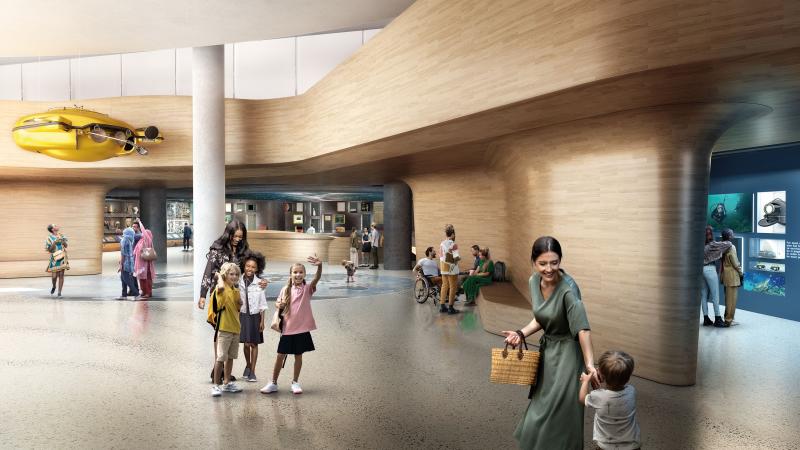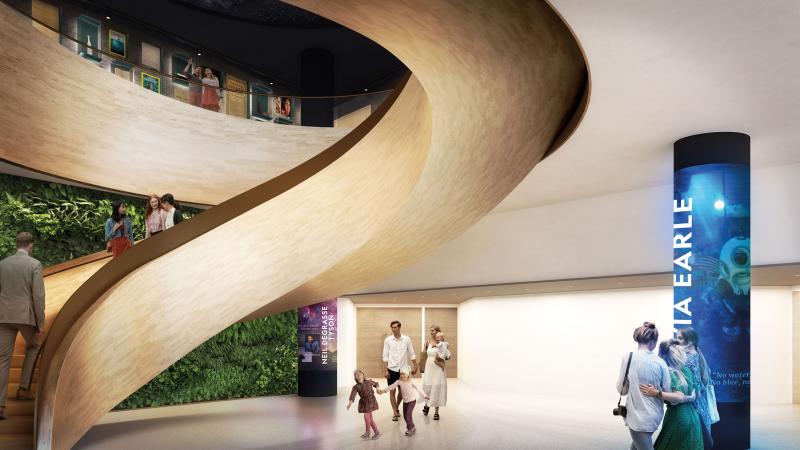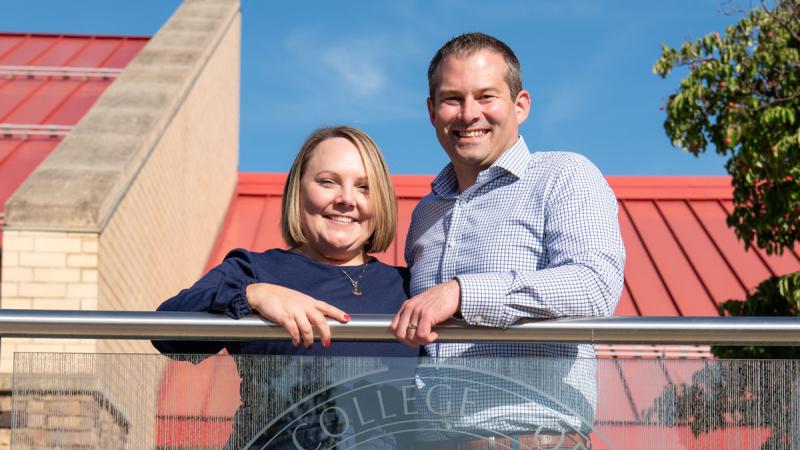Renderings show the future of the National Geographic Society’s public space – now closed for renovations – underway under the helm of Ryan Sokoloski ’08. Since 1888, the Washington, D.C., headquarters has been the place to which explorers have returned to share their experiences. Expansions are designed to make the society’s “Base Camp” a destination to immerse visitors in the society’s renowned photography, storytelling and discoveries. [Visualizations courtesy of National Geographic Society]
Out to change the world
Published 02.16.2024

by Tom Wilson
Writer/Editor-Penn College News
“We’re creating something that’s never been done before.”
A hyperbolic claim in many quarters, perhaps, but not in the measured and reasonable voice of Ryan A. Sokoloski.
The construction management major at Pennsylvania College of Technology – the institution’s first foray into baccalaureate degrees – turned 30 in 2023. And Sokoloski, a 2008 alumnus of the major, has put his considerable skills to work for half of that period, employed by industry leaders at the highest levels of responsibility.
His track record of accomplishment can’t escape the public eye: a hospital for the Army Corps of Engineers, the U.S. Capitol, the Kennedy Center, the Navy Federal Credit Union, Arlington National Cemetery, and a scattering of educational and multifamily buildings.
Sokoloski’s current project may be the grandest of all: a $400 million themed attraction that will completely transform the National Geographic Society’s Washington, D.C., footprint.
Even the most familiar subscriber to the organization’s iconic magazine, its yellow-bordered covers serving for more than a century as an open invitation to global exploration, may be surprised to know that the society is headquartered in the nation’s capital. Or that there’s even a museum, hidden and unheralded, only several blocks north of the White House.
“We’ve struggled for a long time to get people to notice us,” Sokoloski said, “to get them away from the Smithsonian Institution and the Metro stops.”
That will all change in 2026 with the opening of Base Camp, the latest development in the society’s long-standing mission to protect and illuminate the wonders of our natural world. The repurposed space will include a state-of-the-art lobby, theater, photo gallery, immersive experience, archives, exhibition space, a one-of-a-kind outdoor nighttime show, and so much more.
As National Geographic’s director of building operations – and no stranger to bringing the spectacular and the near-impossible into his daily life – Sokoloski is in the center of it all.
Not bad for someone who claims he wasn’t always the best student.
He loved hanging around his father’s construction sites and learning how to pour concrete at Cumberland Valley High School in his Mechanicsburg hometown.
But it wasn’t until the later part of his senior year of high school that he realized the need to knuckle down. Thankfully, he had his father to help point him in the right direction. (Donald A. Sokoloski is a 1983 building construction technology graduate of Williamsport Area Community College, Penn College’s immediate predecessor.) Knowing his son’s passion for building, he nudged Ryan to look into Penn College’s construction management major. He quickly applied during a campus visit.
“If it weren’t for that specific moment, I honestly have no idea where I would be in life,” Sokoloski said. “Not here, I know that.”
His gratitude extends to faculty – primarily Wayne R. Sheppard, the program’s current department head – for helping to focus his career perspective.
“He was tough,” Sokoloski says of the assistant professor. “Freshman year, we started with 34 students, and we ended with nine graduating. Shep told me, ‘It’s what you want to put into it,’ and I knew it was time to get serious.”
Despite his assertion, Sokoloski’s abilities were nowhere near as borderline as he remembers.
He was active on campus, winning a seat as a Student Government Association senator and becoming a founding member of the Sigma Pi fraternity. He also took a leadership role in the Construction Management Association.
“Ryan was a good student in class and was a leader among his classmates,” said Sheppard, who invited him back to campus for a 30th anniversary Alumni in the Classroom presentation in late September.
“I remember speaking with one of his internship companies, and they could not say enough about his maturity and drive,” he added. “While fairly quiet, he also was aggressive in learning and doing. As an alum, he has kept in touch and has tried to offer opportunities to the students coming behind him.”
That drive served him well as he built his Base Camp team, crisscrossing disciplines – from the practical to the creative – with no shortage of specialized needs and divergent opinions.
“It’s like 11 different projects in one,” he explained. “Four existing buildings, all built in different decades. We’re actually working between two buildings and on top of another, so you can imagine how much ‘fun’ we’re having on the structural side.”
Sharing half a city block are Hubbard Hall, built in 1904; the administration building, completed in 1913 and twice renovated; a headquarters completed in the early 1960s; and an M Street office and auditorium added in the mid-1980s.
Not wishing to disrupt the day-to-day operations in an occupied complex, Sokoloski said crews are conducting a “selective demolition” – including containment of asbestos and lead in some of the oldest spaces – and frequently employing hoses to spray down the dust.
The eventual finished project promises so many highlights, featured in a breezy fly-through on the society's website , who knows where to begin?
Any one of the features will dazzle patrons in the years ahead: A three-story pavilion, an education center in the former library, retail space, a new auditorium, archival presentations from the society’s storied past, a public restaurant on the site of the employee cafeteria, and exhibition space for the perennially breathtaking work of renowned photographers.
One of the most-anticipated attractions on the second floor of the 17th Street building – what Sokoloski calls “a walking Disney ride” – will allow visitors to experience exploratory fieldwork in diverse, exciting and remote locations.
And then there is the nighttime extravaganza, an LED media wall on which audiences will watch super-sharp rear projections – with mouths agape, one expects – of sharks, endangered turtles, whales and other digital denizens of the evening air.
All being built with a green mindset, using sustainably sourced materials: recycled and recyclable content when possible, with minimal waste of energy, water, food and other resources. Among the first legs of the project, for instance, was construction of a 45,000-gallon cistern to collect rainwater that will be used for restrooms and to irrigate plants.
Sokoloski tantalized his campus audience with details of the work and arranged for members of the student club to visit the job site. He also gave them some real-world pointers on assembling the best possible team when faced with such an overwhelming assignment.
“Think of all these different people you meet as you move through your career,” he advised during his September visit. “You’re constantly acquiring facts and information, cataloging other people’s skills. I call it ‘natural networking,’ building a supportive system without having to attend those awkward conferences, exchanging business cards with someone who may never call.”
The world of big-city construction is a small one, he said, and – with quality professionals gravitating toward one another – it doesn’t take long for casual relationships to grow into a career-boosting list of contacts.
That doesn’t even count the expertise of his spouse, Hilary J. (Allegretto) Sokoloski, a LEED Accredited Professional with Nestlé USA, whom he met when both were Penn College students. She was a dual major, earning an associate degree in architectural technology and a bachelor’s in residential construction technology & management.
“I owe her a lot of credit, as well, always pushing me,” he said. “We each do our best to make sure the other is as successful as we can be. She’s absolutely crushing it out there; I often ask her for advice!”
In what could be Exhibit A in an imaginary construction management course titled “Don’t Burn Bridges,” Sokoloski owes his current job to an accumulation of professional contacts.
He was employed for 10 years with Gilbane Building Co. in Washington, D.C., alongside fellow Penn College alumni (and brothers) Corey A.’97, Jamie ’03 and Matthew R. ’04 Sarver, who he characterizes as “historical landmarks for the construction management program.” (Sokoloski and Jamie Sarver, whose degree is in building construction technology, worked together on an Arlington National Cemetery project.)
Then came a stint with Jones Lang LaSalle and a project for National Geographic. More time went by, filled with high-end luxury apartments for a developer of multifamily housing, before his previous client – yup, National Geographic – reached out, expressing a keen desire to hire him directly.
The rest is history. And science, geography, anthropology, sociology. Botany, too.
It was through another such relationship that a subcontractor on the Base Camp project was able to quickly pivot, substituting more durable North American ash for the less-desirable oak that was originally intended for the project’s millwork. Sokoloski got word that a family farm in New England was selling its entire stand of trees, which were susceptible to destruction from the emerald ash borer.
Some of the lumber that was inevitably affected by the avaricious beetle displays an exposed gelatinous blue dye from just below the bark, which he said can be incorporated into an educational exhibit in part of the museum.
Like raindrops in the cistern, everything is of use and nothing is wasted.
What I’m trying to do – what National Geographic has always tried to do – is take risks, break barriers and save the planet.









Share your comments
Penn College Magazine welcomes comments that are on topic and civil. Read our full disclaimer.
We love hearing from you